|
|
|
Sort Order |
|
|
|
Items / Page
|
|
|
|
|
|
|
| Srl | Item |
| 1 |
ID:
176225
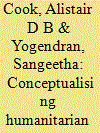

|
|
|
|
|
| Summary/Abstract |
The Asia-Pacific is a dynamic region that is exposed to multiple natural hazards. This article explores how recent developments have influenced the relationship between civilian and military actors in the Asia-Pacific to facilitate an improvement in humanitarian civil–military coordination to assist and protect disaster-affected communities. It investigates civilian and military engagement in disaster preparedness and response activities in the Asia-Pacific, and draws on the literature on civil–military relations and technical reports to further conceptualise these. This article analyses the 4Cs of disaster partnering in humanitarian civil–military partnerships in the Asia-Pacific—(1) Coexistence/Communication, (2) Cooperation, (3) Coordination, (4) Collaboration [Martin, E., I. Nolte, and E. Vitolo. 2016. “The Four Cs of Disaster Partnering: Communication, Cooperation, Coordination and Collaboration.” Disasters 40 (4): 621–643]. It argues that the Regional HADR Coordination Centre (RHCC), UN Cluster System, the Regional Consultative Group on Humanitarian Civil–Military Coordination for Asia and the Pacific (RCG), and Association of South East Asian Nations (ASEAN) centric mechanisms are illustrative of different orders of disaster partnering that are best understood as a combination of distinct and sequential activities. Through a clearer conceptualisation of humanitarian civil–military partnerships in the Asia-Pacific, this article aims to provide more informed expectations on what these partnerships may or may not deliver.
|
|
|
|
|
|
|
|
|
|
|
|
|
|
|
|
| 2 |
ID:
189246
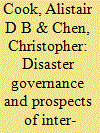

|
|
|
|
|
| Summary/Abstract |
The Southwest Pacific is considered one of the most vulnerable regions in the world to natural hazards. Five of the Pacific Island States (PIS) rank among the top 20 most-at risk countries in the World Risk Index, with Vanuatu and Tonga ranking first and second respectively. The Southwest Pacific neighbours Southeast Asia and both regions are exposed to a variety of natural hazards, resulting in significant damage and loss of lives annually. Similar exposure to climate-induced hazards raises the potential to create a coalition of affected states from the Asia-Pacific to share knowledge of disaster governance in areas where niche capabilities have been developed and shape the global debate on the effects of natural hazards and climate-induced disasters. This article argues that inter-regional partnership on disaster governance is the next step in the Asia-Pacific to respond to a collective action problem affecting two sub-regions - Southeast Asia and the Southwest Pacific. Through the conduct of desk research and interviews, this article first presents findings and observations on the disaster governance landscape and future developments in the Pacific. It then discusses disaster management frameworks and initiatives that ASEAN has institutionalised, and how work in the two sub-regions can complement one another and provide a platform to help shape the global agenda on disaster governance and climate change.
|
|
|
|
|
|
|
|
|
|
|
|
|
|
|
|
| 3 |
ID:
116567
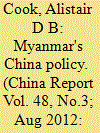

|
|
|
|
|
| Publication |
2012.
|
| Summary/Abstract |
Over the past two decades there has been increasing international attention to the interactions between Myanmar and China. While China has significant influence in relation to other international actors, there is also significant calculation by the government in Myanmar in an effort to ensure that no single external actor calls the policy shots. Instead, the policy choices of the government illustrate that they are calculated on a case-by-case basis to respond to emerging security threats and challenges. However, this represents only a partial truth because there are myriad actors competing for legitimacy in Myanmar which also have various relationships with external actors. Indeed, to fully understand the relationship between Myanmar and China a multifocal lens is required to appreciate the nuances and tensions within Myanmar and their effects on its overarching relationship with China. Furthermore, this lens must also be applied to China, as it too has multiple levels of engagement with Myanmar at both formal and informal levels to varying degrees. This article analyses this complex web of interactions to provide insight into the various agendas, strategies and challenges at play in the relationship between Myanmar and China.
|
|
|
|
|
|
|
|
|
|
|
|
|
|
|
|
| 4 |
ID:
158637
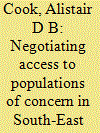

|
|
|
|
|
| Summary/Abstract |
South-East Asia is home to both conflict and ‘natural’ disasters which have caused significant displaced populations. Given this context, there is a need to better understand the motivations of the multiple actors involved in negotiating humanitarian responses, and to account for the impact the finished agreement has on the region both in the short and long terms. This article investigates the motivations behind two humanitarian responses in South-East Asia. The first case is the set of humanitarian responses to the Indochinese exodus in the 1970s and 1980s. The second case is the humanitarian response to those affected by Cyclone Nargis in Myanmar during the late 2000s and early 2010. Both of these agreements have been held up as historic and ground breaking achievements within the international relations of South-East Asia. This article assesses these agreements to identify the multiple levels of governance involved and the individual actors’ motivations behind them. It argues that greater appreciation of these dynamics will contribute to understanding the governance of humanitarian responses to populations of concern in South-East Asia. This will be important to consider as new crises emerge that demand new negotiations within a crowded field of actors governing humanitarian responses in the region.
|
|
|
|
|
|
|
|
|
|
|
|
|
|
|
|
| 5 |
ID:
098798
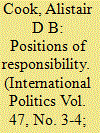

|
|
|
|
|
| Publication |
2010.
|
| Summary/Abstract |
Recent challenges have tested the approaches of both the Association of Southeast Asian Nations (ASEAN) and the European Union (EU) to adequately respond to forced migration in Myanmar. This article provides a comparison between the European sanctions regime and ASEAN's 'constructive engagement' with Myanmar. In the aftermath of Cyclone Nargis, it is ASEAN, along with the United Nations (UN), that has offered an effective mechanism to access populations of concern in Myanmar. This article draws on the experience of the UN High Commission for Refugees on the western border and argues that while the new ASEAN-UN-led mechanism offers a new way to assist people in the delta region, this access is contingent on three constraints: maintenance of personal relations with military decision-makers, continuation of an ASEAN-UN-led mechanism and ongoing funding from donor nations.
|
|
|
|
|
|
|
|
|
|
|
|
|
|
|
|
|
|
|
|
|